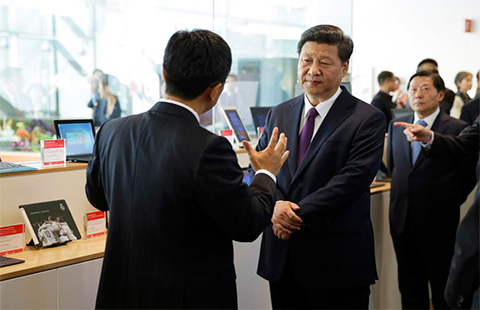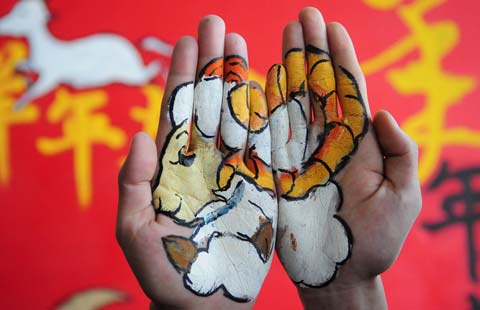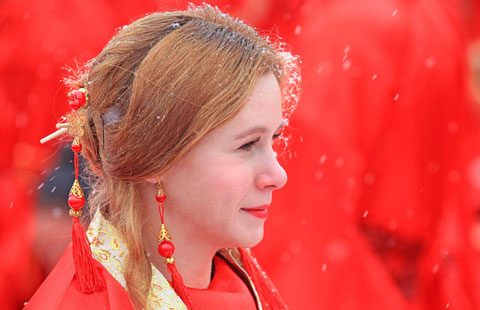Ethnic equality, unity and development in Xinjiang
Updated: 2015-09-25 06:33
(China Daily)
|
||||||||
I. Implementing the System of Ethnic Regional Autonomy
Located in China's northwest, Xinjiang was documented as forming part of China's territories as early as 60 BC, and went on to become an integral part of the unified and multiethnic country. In light of the actual local conditions, the central governments in successive dynastic periods adopted various different forms of governance in this region. During the process of creating and developing a unified and multiethnic country, all the ethnic peoples of Xinjiang developed close ties and became integrated as one.
Known for their hard working, wisdom and bravery, the ethnic groups of Xinjiang created a distinctive multiethnic culture, which became an important part of overall Chinese culture. Xinjiang also became a key gateway connecting China with the rest of the world and disseminating diverse cultures.
After the First Opium War (1840-1842), China was gradually reduced to a semi-colonial and semi-feudal society, and the ethnic peoples of Xinjiang suffered oppression under the foreign aggressors, feudal forces and exploiting classes, falling to the bottom of society.
By the late 1940s, most of the arable land in the farming areas of southern Xinjiang, Ili and Urumqi had been seized by a handful of landlords, leaving very little to the majority of peasants. In the remote villages inhabited by Uygur peasants in southern Xinjiang, a small number of serf owners' estates existed in relatively complete form. The overlords of these estates owned their serfs from head to toe, and the serfs were forced to work their masters' lands without payment and to perform all kinds of domestic chores. In the pastoral areas of northern Xinjiang, remnants of the feudal clan system were evident in that the nobility and the clan chiefs not only held large herds of livestock, but also enjoyed all kinds of feudal privileges.
Before the founding of the People's Republic of China, Xinjiang lagged far behind the rest of the country in economic and social development, and the ethnic peoples there lived in dire poverty and were deprived of basic human rights.
Founded in 1921, the Communist Party of China (CPC) took as its mission the search for a right path to realize national independence and the liberation of the people, including the ethnic peoples of Xinjiang. In its early days, the CPC sent some of its members to Xinjiang to carry out revolutionary work. During the Chinese people's War of Resistance againstJapanese Aggression, the people of all ethnic groups in Xinjiang lent their support to the cause of resistance through various means under the leadership of the CPC. A number of revolutionary youth, influenced by progressive ideas, actively mobilized the peoples of Xinjiang to fight against reactionary and backward forces. The common call of history convinced them that only the CPC could save China - a prerequisite for the consensus against which Xinjiang later greeted its peaceful liberation.
In September 1949, Xinjiang was liberated peacefully, thanks to the efforts made by people of all ethnic groups there. On October 1, together with all their fellow countrymen, the ethnic peoples of Xinjiang witnessed the founding of the People's Republic of China. After liberation, Xinjiang kept its provincial system.
On December 17, 1949, under the leadership of the CPC Central Committee and the CPC Xinjiang Bureau, the Xinjiang provincial people's government was established. Represented by deputies from all ethnic groups and social sectors in Xinjiang, and with Burhan al-Shahidi as chair, this opened a new leaf in the development of a new people's democratic government. Under the leadership of the CPC, and with the strong support of the ChinesePeople's Liberation Army, the provincial government of Xinjiang led the local ethnic peoples in successfully quelling revolts, suppressing bandits and putting down reactionary armed rebellions. The uprising troops of the former regime and ethnic armed forces were regrouped.
In line with the principles of equality, unity, and mutual assistance for ethnic groups, the peoples of Xinjiang became the masters of the region, and for the first time elected deputies to the people's congresses at all levels. The democratic reform that followed, with rural land reform at its core, abolished feudal land ownership and distributed land to the deprived local peasants, putting an end once and for all to centuries of oppression and exploitation for the working people of Xinjiang.
The People's Republic of China has upheld ethnic equality, unity, common prosperity and development of all ethnic groups as the basic principles in solving ethnic problems and handling ethnic relations. It made it a state policy to practice ethnic regional autonomy in areas where people of ethnic minorities live in concentrated communities. When the People's Republic of China was founded in 1949, the ethnic peoples of Xinjiang mainly comprised the Uygur, Han, Kazak, Hui, Kirgiz, Mongolian, Xibe, Tajik, Manchu, Uzbek,Russian, Daur and Tartar, with the Uygurs boasting the largest population. Each of these ethnic groups was characterized by living in homogenous communities of its own, or by living together with or mixing with other groups, and the various peoples maintained close and extensive relations - a continuation of the traditional lifestyle. The practice of ethnic regional autonomy in Xinjiang has ensured the democratic rights of all ethnic peoples in the region, making them the masters of Xinjiang. It is also of great significance in strengthening the harmonious relationship of equality, unity and mutual assistance of the various ethnic groups, safeguarding national unification, accelerating economic development, and promoting social progress in Xinjiang.
- Another corruption suspect repatriated from US to China
- Shanghai slaps three-year ban on entertainers caught doing drugs
- 37 students critical after botched fire drill in NW China
- Man writes Chinese calligraphy using kitchenware
- Brilliant Autumn Urumqi feasting many eyes
- Kids serve as traffic police in C China
- Colombia, FARC reach breakthrough agreement in Havana
- White House prepares for government shutdown
- EU leaders seek unity on refugee plans
- EU pushes through plan to relocate 120,000 refugees amid oppositions
- China, Malaysia conclude first joint military exercise
- Hillary Clinton opposes controversial oil pipeline

 Here's what's on the menu for the state dinner
Here's what's on the menu for the state dinner
 President Xi visits Microsoft campus in Seattle
President Xi visits Microsoft campus in Seattle-
 Xi revisits Lincoln High School after 1993 bond
Xi revisits Lincoln High School after 1993 bond 
 Chinese, US business leaders gather at roundtable meeting
Chinese, US business leaders gather at roundtable meeting-
 Xi visits assembly line of plane manufacturer Boeing in US
Xi visits assembly line of plane manufacturer Boeing in US -
 First Lady tours Fred Hutchson Cancer Research Center
First Lady tours Fred Hutchson Cancer Research Center 
 Boeing to sell 300 planes to China
Boeing to sell 300 planes to China-
 Sino-US ties need more understanding: Xi
Sino-US ties need more understanding: Xi
Most Viewed
Editor's Picks

|

|

|

|

|

|
Today's Top News
Young people from US look forward to Xi's state visit: Survey
US to accept more refugees than planned
Li calls on State-owned firms to tap more global markets
Apple's iOS App Store suffers first major attack
Japan enacts new security laws to overturn postwar pacifism
Court catalogs schools' violent crimes
'Beauty of Beijing's alleys akin to a wise, old person'
China makes progress fighting domestic, international cyber crime
US Weekly

|

|








